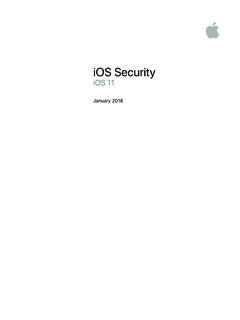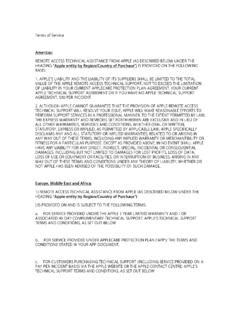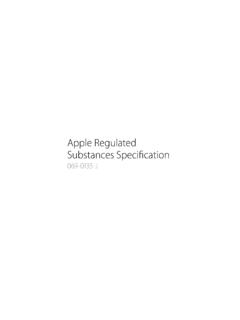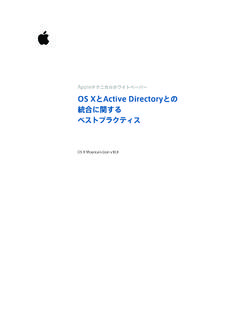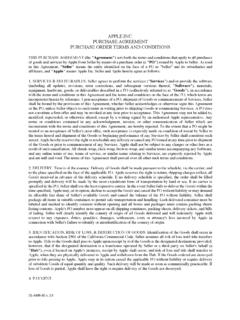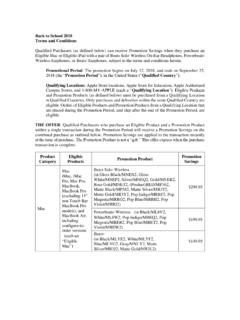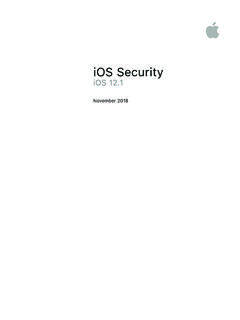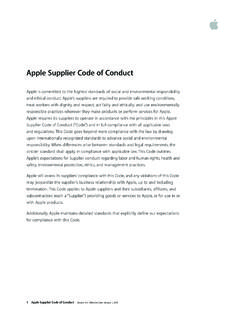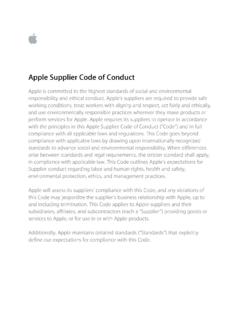Transcription of ARTICLE ORGANIZATIONAL CULTURE How Apple Is …
1 REPRINT R2006 FPUBLISHED IN HBRNOVEMBER DECEMBER 2020 ARTICLEORGANIZATIONAL CULTUREHow Apple Is Organized for InnovationIt s about experts leading experts. by Joel M. Podolny and Morten T. HansenThis ARTICLE is made available to you with compliments of Apple Inc for your personal use. Further posting, copying or distribution is not Business ReviewNovember December 2020 This ARTICLE is made available to you with compliments of Apple Inc for your personal use. Further posting, copying or distribution is not MIKAEL JANSSONHow Apple Is Organized for InnovationIt s about experts leading CULTUREJoel M. PodolnyDean, Apple UniversityMorten T. HansenFaculty, Apple UniversityAUTHORSFOR ARTICLE REPRINTS CALL 800-988-0886 OR 617-783-7500, OR VISIT Business ReviewNovember December 2020 3 This ARTICLE is made available to you with compliments of Apple Inc for your personal use.
2 Further posting, copying or distribution is not KNOWN FOR ITS innovations in hardware, software, and services. Thanks to them, it grew from some 8,000 employees and $7 billion in revenue in 1997, the year Steve Jobs returned, to 137,000 employees and $260 billion in revenue in 2019. Much less well known are the ORGANIZATIONAL design and the associated leadership model that have played a crucial role in the company s innovation Jobs arrived back at Apple , it had a conventional structure for a company of its size and scope. It was divided into business units, each with its own P&L responsibilities. General managers ran the Macintosh products group, the information appliances division, and the server products division, among others.
3 As is often the case with decentral-ized business units, managers were inclined to fight with one another, over transfer prices in particular. Believing that conventional management had stifled innovation, Jobs, in his first year returning as CEO, laid off the general managers of all the business units (in a single day), put the entire com-pany under one P&L, and combined the disparate functional departments of the business units into one functional organi-zation. (See the exhibit Apple s Functional Organization. )The adoption of a functional structure may have been un surprising for a company of Apple s size at the time. What is surprising in fact, remarkable is that Apple retains it today, even though the company is nearly 40 times as large in terms of revenue and far more complex than it was in 1998.
4 Senior vice presidents are in charge of functions, not products. As was the case with Jobs before him, CEO Tim Cook occupies the only position on the ORGANIZATIONAL chart where the design, engineering, operations, marketing, and retail of any of Apple s main products meet. In effect, besides the CEO, the company operates with no conventional general managers: people who control an entire process from product development through sales and are judged according to a P&L history and ORGANIZATIONAL theory make the case that as entrepreneurial firms grow large and complex, they must shift from a functional to a multidivisional structure to align accountability and control and prevent the congestion that occurs when countless decisions flow up the org chart to the very top.
5 Giving business unit leaders full control over key functions allows them to do what is best to meet the needs of their individual units customers and maximize their results, and it enables the executives overseeing them to assess their performance. As the Harvard Business School historian Alfred Chandler documented, companies such as DuPont and General Motors moved from a functional to a multidivisional structure in the early 20th century. By the latter half of the century the vast majority of large corpora-tions had followed suit. Apple proves that this conventional approach is not necessary and that the functional structure may benefit companies facing tremendous technological change and industry s commitment to a functional organization does not mean that its structure has remained static.
6 As the importance of artificial intelligence and other new areas has increased, that structure has changed. Here we discuss the innovation benefits and leadership challenges of Apple s distinctive and ever-evolving ORGANIZATIONAL model, which may be useful for individuals and companies wanting to better understand how to succeed in rapidly changing CHALLENGEM ajor companies competing in many industries struggle to stay abreast of rapidly changing MAJOR CAUSEThey are typically organized into business units, each with its own set of functions. Thus the key decision makers the unit leaders lack a deep understanding of all the domains that answer to Apple MODELThe company is organized around functions, and expertise aligns with decision rights.
7 Leaders are cross-functionally collaborative and deeply knowledgeable about IN BRIEFA pple isORGANIZATIONAL CULTURECOPYRIGHT 2020 HARVARD BUSINESS SCHOOL PUBLISHING CORPORATION. ALL RIGHTS Business ReviewNovember December 2020 This ARTICLE is made available to you with compliments of Apple Inc for your personal use. Further posting, copying or distribution is not A FUNCTIONAL ORGANIZATION? Apple s main purpose is to create products that enrich people s daily lives. That involves not only developing entirely new product categories such as the iPhone and the Apple Watch, but also continually innovating within those categories. Perhaps no product feature better reflects Apple s commitment to continuous innovation than the iPhone cam-era.
8 When the iPhone was introduced, in 2007, Steve Jobs devoted only six seconds to its camera in the annual keynote event for unveiling new products. Since then iPhone camera technology has contributed to the photography industry with a stream of innovations: High dynamic range imaging (2010), panorama photos (2012), True Tone flash (2013), opti-cal image stabilization (2015), the dual-lens camera (2016), portrait mode (2016), portrait lighting (2017), and night mode (2019) are but a few of the create such innovations, Apple relies on a structure that centers on functional expertise. Its fundamental belief is that those with the most expertise and experience in a domain should have decision rights for that domain.
9 This is based on two views: First, Apple competes in markets where the rates of technological change and disruption are high, so it must rely on the judgment and intuition of people with deep knowledge of the technologies responsible for disruption. Long before it can get market feedback and solid market forecasts, the company must make bets about which technologies and designs are likely to succeed in smart-phones, computers, and so on. Relying on technical experts rather than general managers increases the odds that those bets will pay , Apple s commitment to offer the best possible products would be undercut if short-term profit and cost ABOUT THE ARTA pple Park, Apple s corporate headquarters in Cupertino, California, opened in Jansson/Trunk ArchiveFOR ARTICLE REPRINTS CALL 800-988-0886 OR 617-783-7500, OR VISIT Business ReviewNovember December 2020 5 This ARTICLE is made available to you with compliments of Apple Inc for your personal use.
10 Further posting, copying or distribution is not were the overriding criteria for judging investments and leaders. Significantly, the bonuses of senior R&D exec-utives are based on companywide performance numbers rather than the costs of or revenue from particular products. Thus product decisions are somewhat insulated from short-term financial pressures. The finance team is not involved in the product road map meetings of engineering teams, and engineering teams are not involved in pricing don t mean to suggest that Apple doesn t consider costs and revenue goals when deciding which technologies and features the company will pursue. It does, but in ways that differ from those employed by conventionally organized companies.
